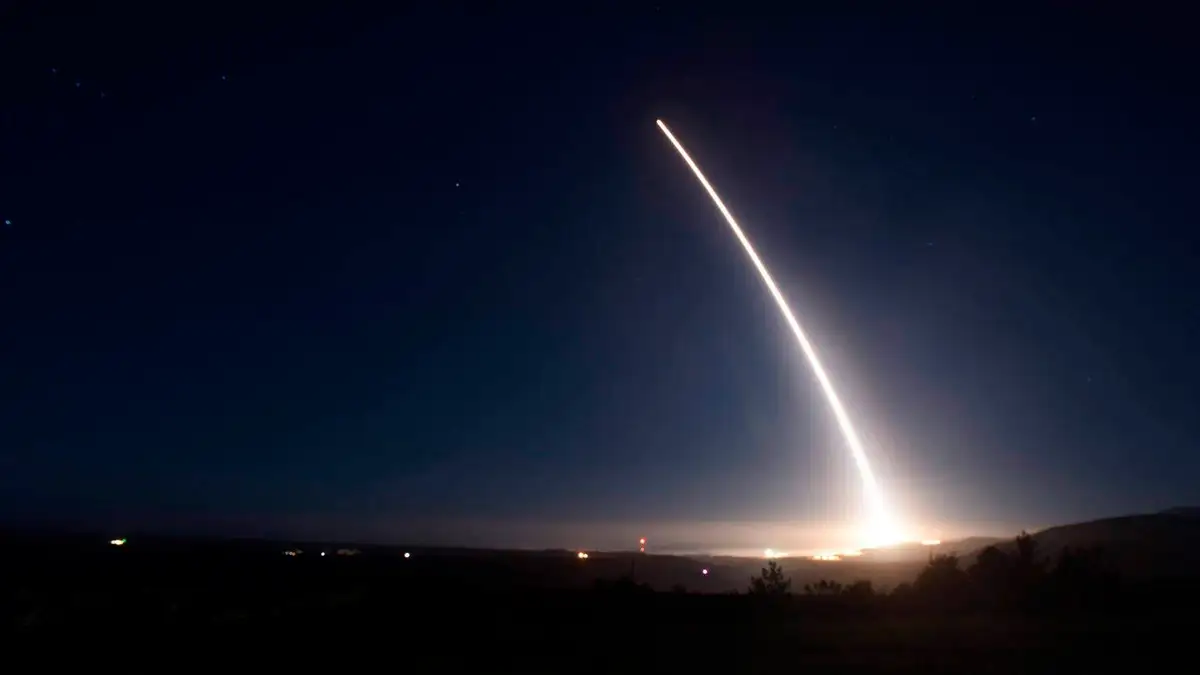
FILE - In this Saturday, Feb. 20, 2016 file photo provided by U.S. Air Force, an unarmed Minuteman III intercontinental ballistic missile launches during an operational test at Vandenberg Air Force Base, Calif. (AP)
An unarmed Minuteman 3 nuclear missile was shot into the California night sky Thursday amid tensions with North Korea and Russia.
The missile was fired at 11:01 p.m. off the California coastline and was carrying a payload of test instruments. It was aimed toward the waters of the Kwajalein Atoll, an island chain about 2,500 miles southwest of Honolulu.
Col. Craig Ramsey, commander of the 576th Flight test Squadron, said the re-entry vehicle that carries the missile’s payload reached its target 30 minutes after the launch.
This was the second missile test the Air Force conducted this month in a series designed to confirm the reliability of the Cold War-era missile and all its components. The Minuteman 3, first deployed in 1970, has long exceeded its original 10-year lifespan. It is so old that vital parts are no longer in production.
The Air Force operates 450 Minuteman missiles -- 150 at each of three missile fields in Wyoming, Montana and North Dakota. A few times a year, one missile is pulled from its silo and trucked to Vandenberg, minus its nuclear warhead, for a test launch.
Minuteman test launches are the U.S. military's way of sharpening the message that forms the foundation of U.S. nuclear deterrence theory — that if potential attackers believe U.S. nuclear missiles and bombs are ready for war at all times, then no adversary would dare start a nuclear fight.
The credibility of this message can be damaged by signs of weakness or instability in the nuclear weapons force. In 2013-14 the Associated Press documented morale, training, leadership and equipment problems in the Minuteman force, and in January the Air Force acknowledged to the AP that errors by a maintenance crew damaged an armed Minuteman in May 2014.
Work said in an interview ahead of Thursday's launch that he sees good progress in fixing the problems in the nuclear missile corps. He also said the Vandenberg test launches are critically important.
"It is a signal to anyone who has nuclear weapons that we are prepared to use nuclear weapons in defense of our country, if necessary," he said, adding later, "We do it to demonstrate that these missiles —- even though they're old — they still remain the most effective, or one of the most effective, missiles in the world."
Work also mentioned that the launch sends a message to strategic rivals – including Russia, China and North Korea. He said “that’s exactly why we do this,” according to Reuters.
"We and the Russians and the Chinese routinely do test shots to prove that the operational missiles that we have are reliable. And that is a signal ... that we are prepared to use nuclear weapons in defense of our country if necessary."
Air Force official claim the test launches are a morale booster because they give launch crews and others a chance to leave their usual duties to participate in an actual launch. Otherwise, officials do 24-hour shifts, year-round, in underground missile posts, hoping the call to combat never comes.
Together, the United States and Russia control the vast majority of the world's nuclear weapons, and both countries regularly conduct ICBM test launches. The Russians generally do them more often, at least in part because they have new missiles in development whereas the Minuteman 3 is the only U.S. ICBM. The U.S. Air Force is planning a new-generation ICBM, but it is not scheduled to begin entering the force until about 2030.
Pavel Podvig, an independent analyst of Russian nuclear forces and publisher of the RussianForces.org blog, said in an interview that Moscow puts less stock in the public messaging aspect of missile test launches than does Washington.
"They (the Russians) do want to make sure the missiles are still functioning," he said, "But the message is as much for themselves as for the outside world."
North Korea, on the other hand, aims for maximum political impact when it conducts missile test launches or detonates a nuclear device, as it did Jan. 6. The potential for North Korea to field a nuclear warhead small enough to fit atop an intercontinental missile is among the worries American officials cite as justification for investing tens of billions of dollars in a new fleet of U.S. ICBMs and other types of nuclear weaponry.
The Associated Press contributed to this report.





















